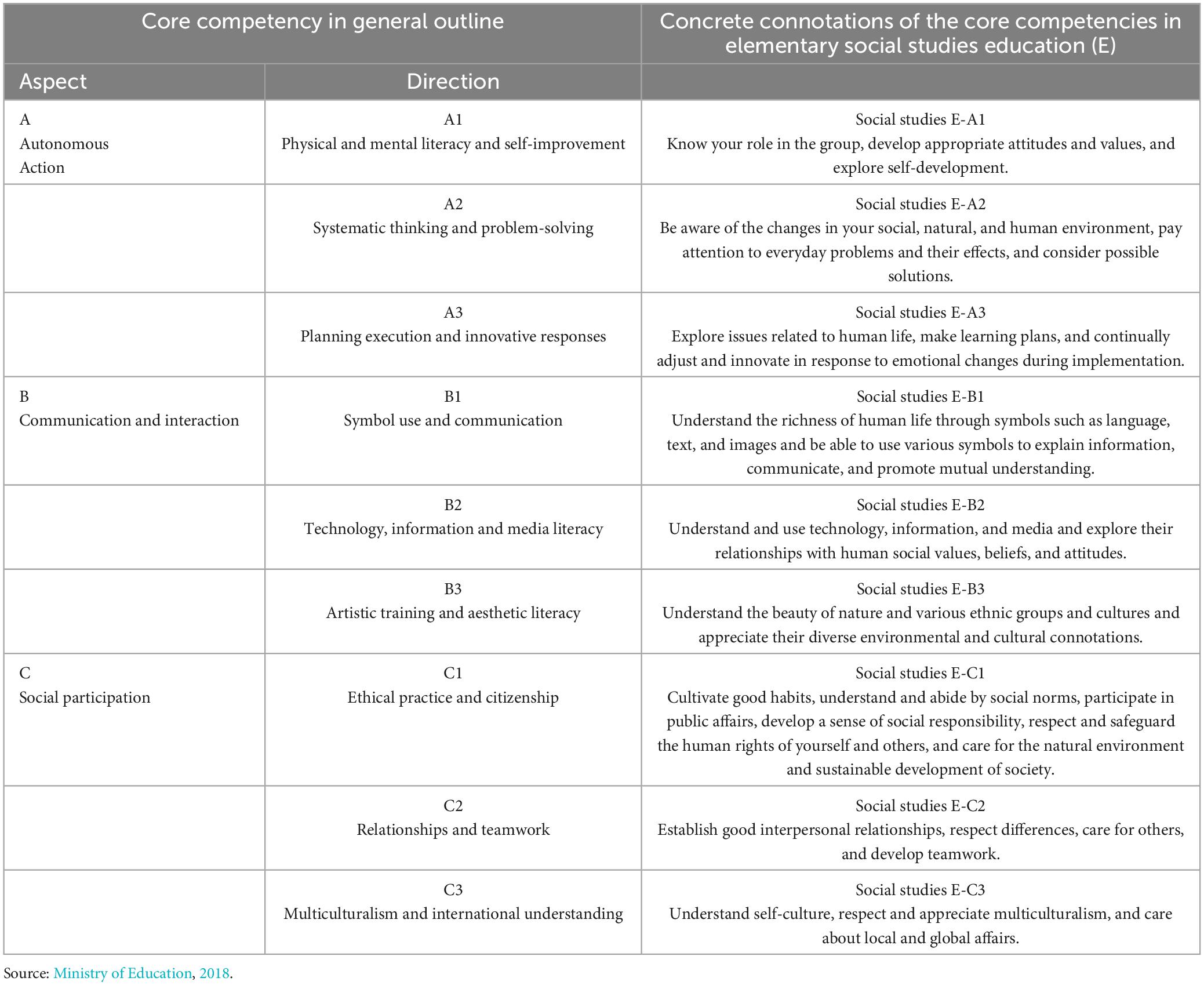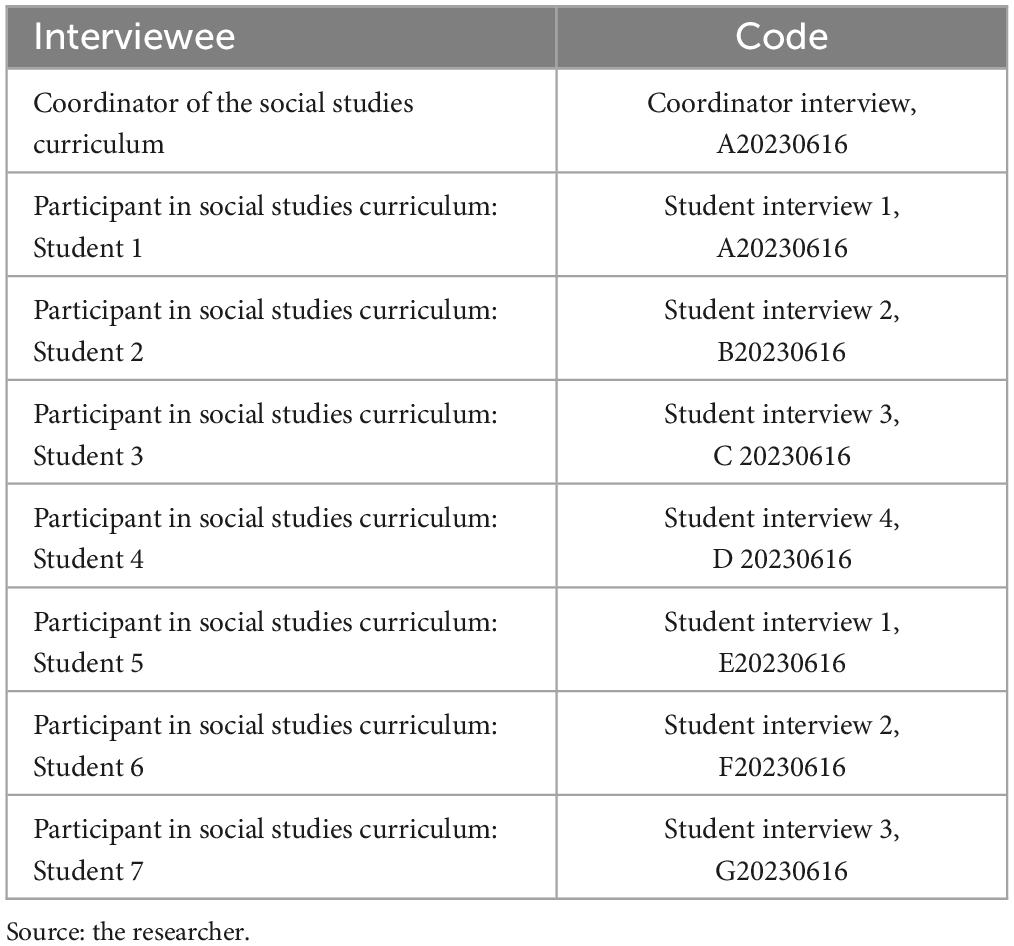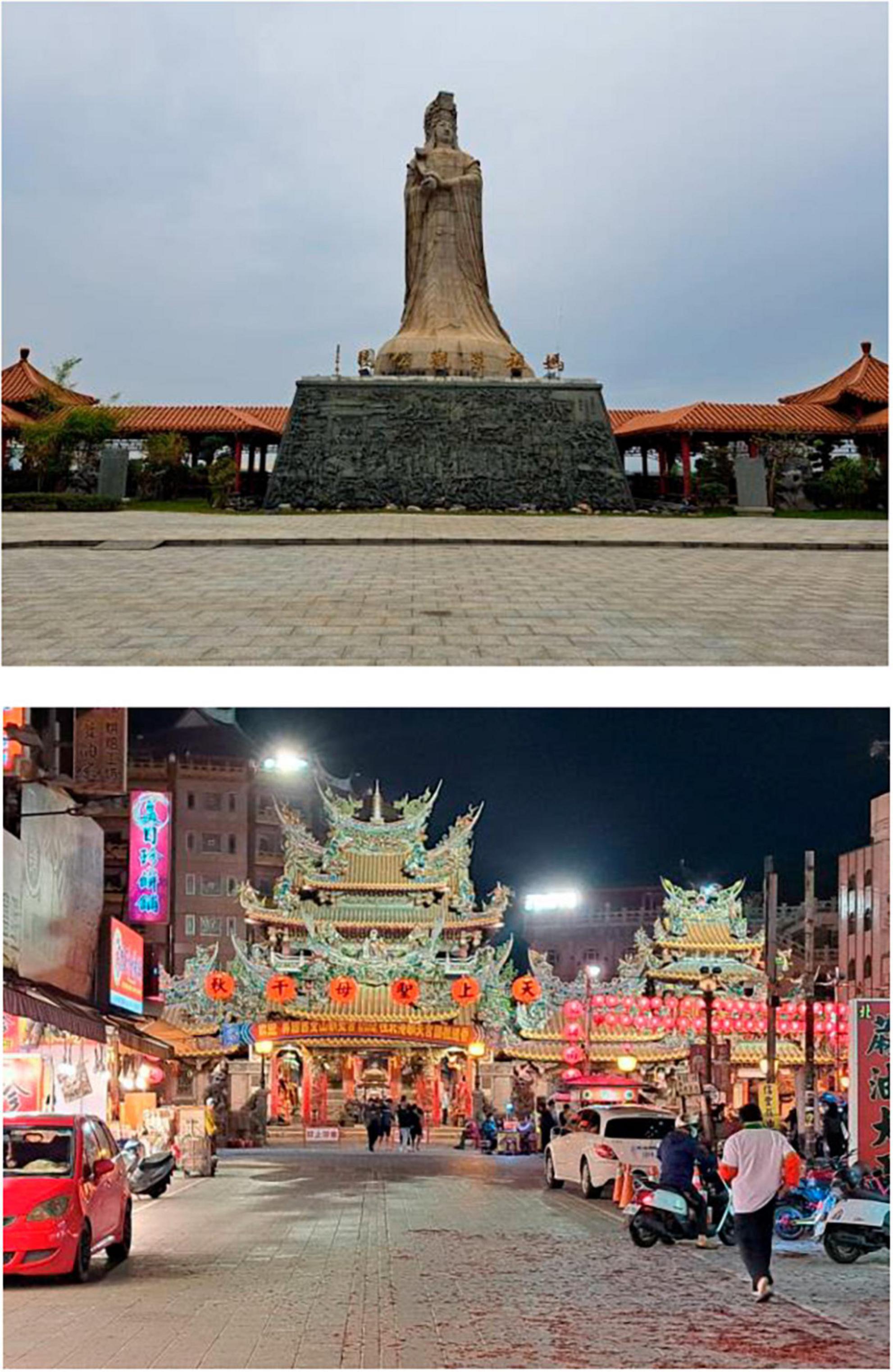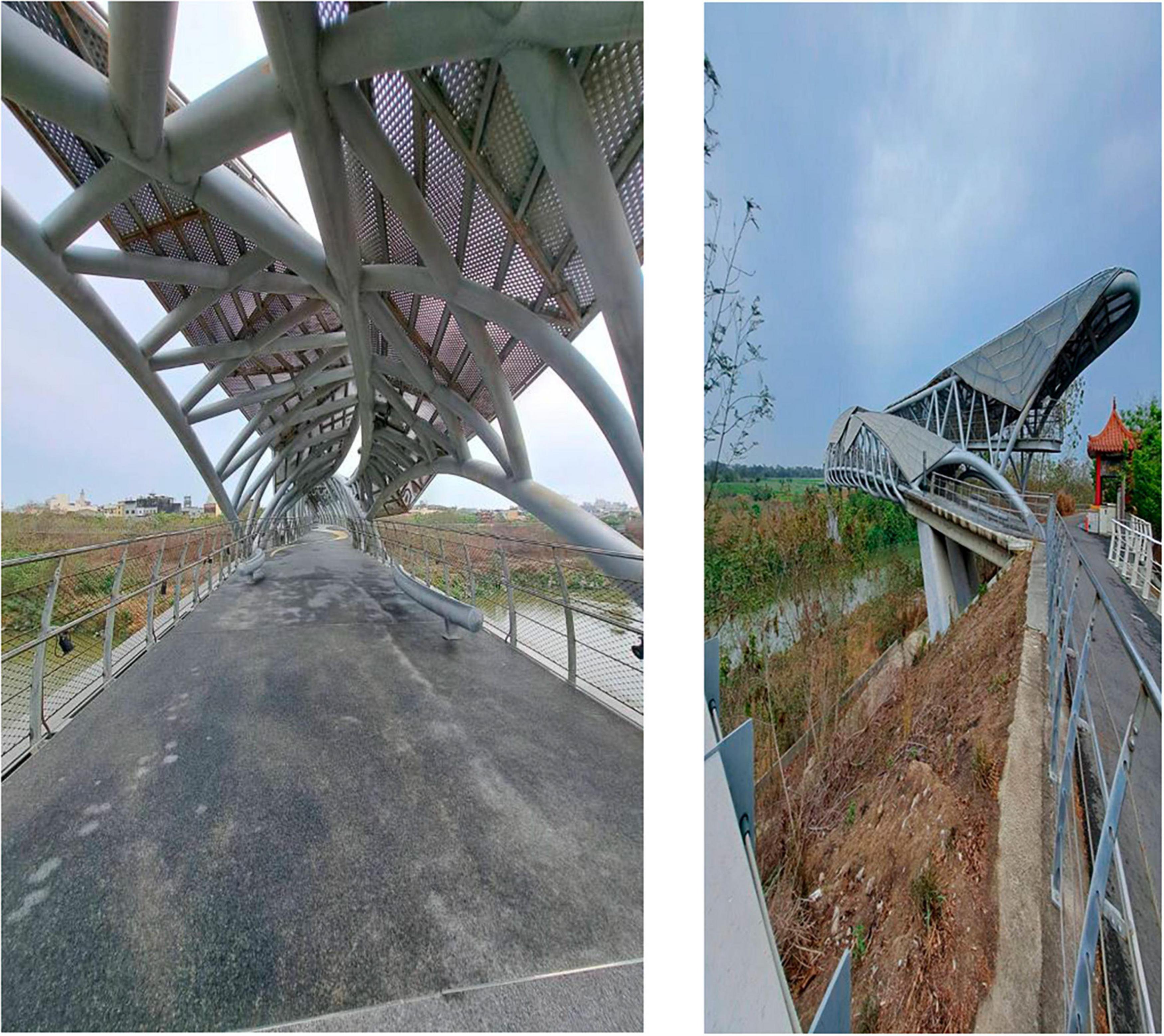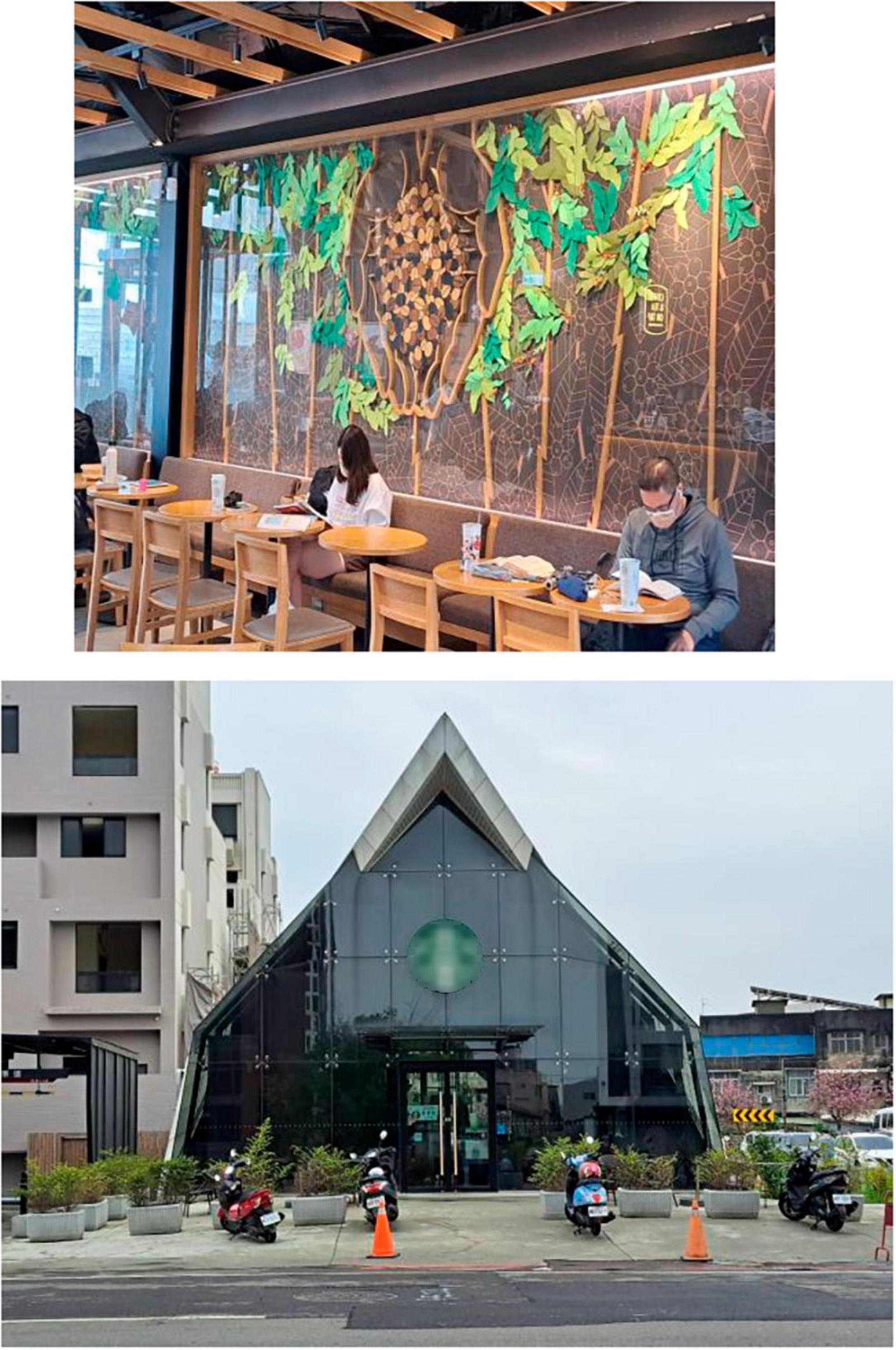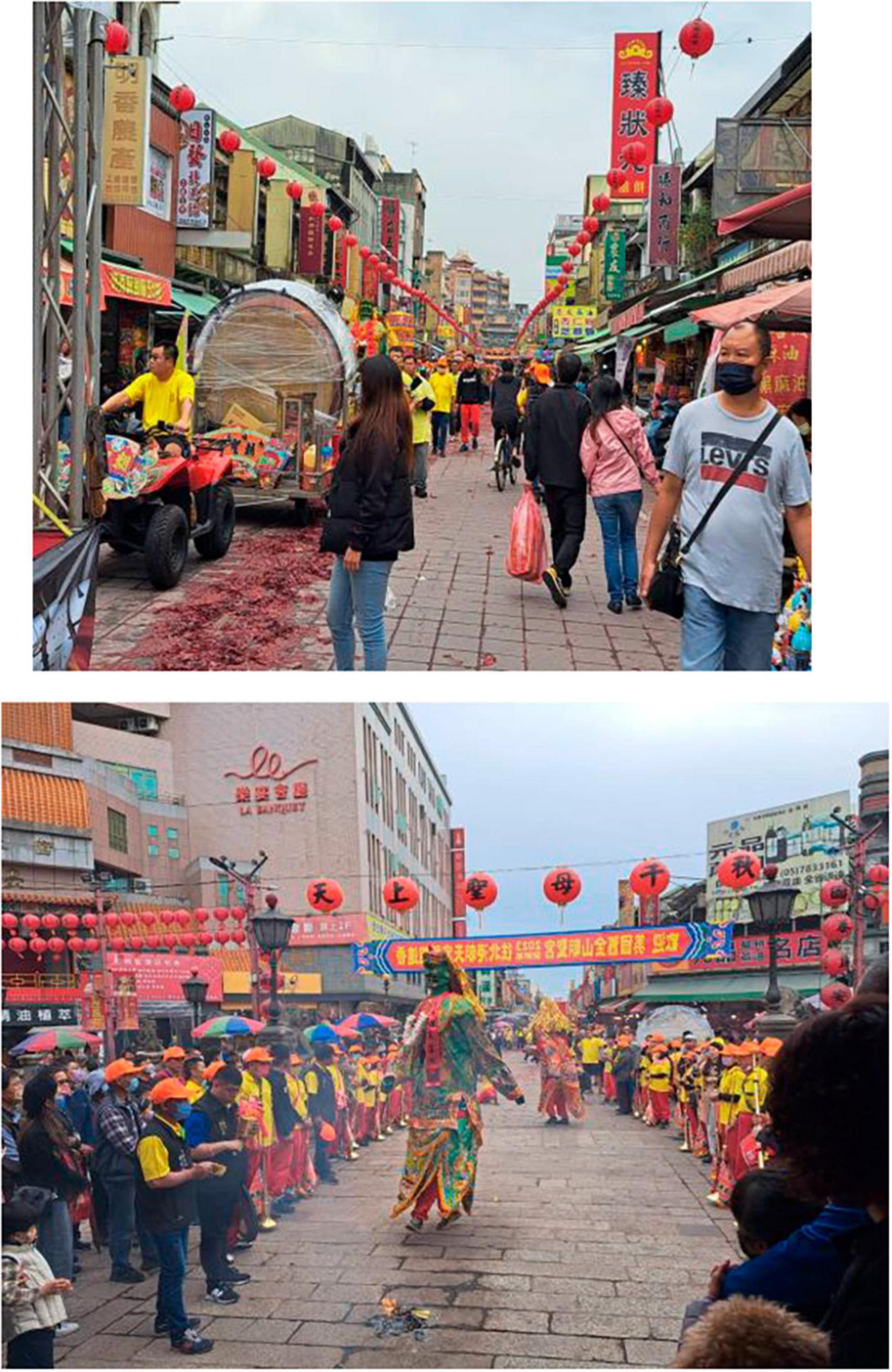- Minghsin University of Science and Technology, Hsinchu, Taiwan
Introduction: The primary aim of social studies education is to convey knowledge about cultural and social systems while fostering inquiry, participation, practice, reflection, and innovation. Social studies education plays a pivotal role in raising awareness about various ethnic groups, societies, localities, countries, and the world at large. Furthermore, it instills in students a sense of responsibility, leading them to embrace diversity, value human rights, and promote global sustainability. The current elementary social studies curriculum in Taiwan strongly aligns with these principles and is a vehicle for sustainable development in society.
Methods: The researcher used qualitative research methods and adopted a case study design to review the pedagogical design of the elementary social studies curriculum in Taiwan as a means of sustainability education and enriching children’s cultural learning in the context of sustainability. Children’s learning related to sustainability in an elementary school was investigated, and a social studies teaching design was developed. Finally, the developed teaching approach was implemented in a classroom setting.
Results and discussion: The study yielded the following findings: (1) The social studies curriculum development in Taiwan is connected to the pulse of life, a sense of care for local communities, and cultivation of local thinking. (2) This social studies curriculum adopts a child-centered and problem-oriented approach and integrates students’ interests and the local environment into the learning process. (3) It effectively enhances students’ sustainability-related competencies and skills. These findings offer valuable insights for teachers and can enable them to shape the direction of their social studies courses and cultivate children’s concept of sustainable development for their living environment.
1 Introduction
In Taiwan, the Curriculum Guidelines of the 12-Year Basic Education introduced herein adopt the vision of developing talent in every student—nurture by nature, and promoting life-long learning. In addition, the guidelines cater to the specific needs of all individuals, take into account the diverse cultures and differences between ethnic groups, and pay attention to socially vulnerable groups. The goal is to provide adequate education that elicits students’ enjoyment and confidence in learning. This facilitates raising students’ thirst for learning and courage to innovate creation, prompting them to fulfill their civic responsibilities and develop the wisdom for symbioses, and helping them engage in lifelong learning and develop excellent social adaptability. Accordingly, the vision of a more prosperous society with higher quality of life among individuals can be achieved (Ministry of Education, 2014; Wang and Shih, 2022).
Seeking the “common good” in curriculum development can improve quality of life by promoting harmony and wellbeing. A curriculum based on seeking the common good can encourage students to care for others, participate in activities, protect for the natural environment, self-reflect, and develop sustainable practices for the society (Ministry of Education, 2014). The goal of social studies education is to transmit knowledge of cultural and social systems and cultivate inquiry, participation, practice, reflection, and innovation. Social studies education promotes seeking the common good and instills social practices in students. Social studies education raises awareness of ethnic groups, societies, localities, countries, and the world and imbues students with a sense of responsibility, enabling them to recognize diversity, value human rights, and promote global sustainability (Ministry of Education, 2018). Taiwan’s current elementary social studies curriculum promotes these aforementioned principles, all of which relate to sustainable development for our society.
This study conducted a comprehensive review of the elementary social studies curriculum in Taiwan, focusing on its role as a platform for sustainability education and its fostering of children’s cultural learning related to sustainability. The design of a cultural course centered on the town of Beigang was employed as an example; the aim of such a course is to ensure that children are proactive, engage with their environment, and ultimately seek the common good in society in Taiwan.
2 Theoretical perspective: the Curriculum Guidelines for 12-Year Basic Education: general guidelines
Taiwan’s 12-Year Basic Education was first implemented in August 2014, and the Ministry of Education announced the Curriculum Guidelines for 12-Year Basic Education: general guidelines in November 2014. The New Curriculum reflects the idea that the 12-year basic education curriculum guidelines should be based on the principle of holistic education, incorporating the ideas of “taking initiative,” “engaging in interaction,” and “seeking the common good” (Ministry of Education, 2014; Shih et al., 2020; Wang and Shih, 2022). The idea of Curriculum Guidelines for 12-Year Basic Education: general guidelines is illustrated in Figure 1.

Figure 1. The idea of Curriculum Guidelines for 12-Year Basic Education: general guidelines (source: Ministry of Education, 2014).
The Curriculum Guidelines of the 12-Year Basic Education was developed based on the spirit of holistic education, adopting the concepts of taking initiative, engaging in interaction, and seeking the common good to encourage students to become spontaneous and motivated learners. The curriculum also urges that schools be active in encouraging students to become motivated and passionate learners, leading students to appropriately develop the ability to interact with themselves, others, society, and nature. Schools should assist students in applying their learned knowledge, experiencing the meaning of life, and developing the willingness to become engaged in sustainable development of society, nature, and culture, facilitating the attainment of reciprocity and the common good in their society.
The theoretical perspective of this study is based on the concept of the Curriculum Guidelines for 12-Year Basic Education: general guidelines, including the concepts of taking initiative, engaging in interaction, and seeking the common good. The concepts of taking initiative, engaging in interaction, and seeking the common good for philosophical foundation of the curriculum in Taiwan. Based on the above-mentioned educational concepts, the cultural curriculum of Beigang is designed. Children can proactively protect Taiwan’s cultural and natural heritage and the cultural landscape that embodies the collective memory and history of the people on the land in the future. Seeking the common good for people in Taiwan.
2.1 The practice of the new curriculum is based on “core competency”
The practice of the New Curriculum is based on “core competency” as its main axis and consists of three dimensions: “autonomous action,” “communication and interaction,” and “social participation” (Ministry of Education, 2014). In August 2019, the New Curriculum was formally implemented in Taiwan’s education system.
To implement the ideas and goals of 12-Year Basic Education, core competencies are used as the basis of curriculum development to ensure continuity between educational stages, bridging between domains, and integration between subjects. Core competencies are primarily adopted in the general domains and subjects of elementary school (Ministry of Education, 2014).
The Meaning of “core competency” in social studies refers to the knowledge, ability, and attitude that students should possess for everyday life and challenges. When students face uncertain or complex situations, they can apply their subject knowledge through thinking and exploration, situational analysis, and questions or hypotheses. Ultimately, students can apply comprehensive learning strategies that are suitable for solving problems in their everyday life (Ministry of Education, 2014, 2018).
2.2 The goals in social studies
The curriculum outline for social studies (hereinafter, “Social Studies Outline”) is rooted in “maximizing students’ talent” and developing lifelong learning, as described by the Curriculum Guidelines of 12-Year Basic Education. According to the general outline, humanities and social sciences are core subjects that should be taught step by step. The curriculum mainly focuses on interests and inquiry regarding the three subjects of history, geography, and civics and society. The curriculum has the following goals (Ministry of Education, 2014, 2018):
Consider the diverse backgrounds and life experiences of students (e.g., culture, ethnicity, physical location, gender, and physical and mental characteristics) and promote career exploration and development to establish an independent learning space (Ministry of Education, 2018).
Consider the regional, ethnic, and school characteristics for curriculum development (Ministry of Education, 2018).
Establish vertical and horizontal integration within the studies through the following strategies (Ministry of Education, 2018):
Have studies/subjects at each educational stage be guided by civic literacy and the themes of exploration and practical activities that provide space for collaboration on various subjects and issues in the social studies (Ministry of Education, 2018).
Prioritize real-world experience, accounting for the development of knowledge, positive attitudes, and practical skills for subjects at each learning stage (Ministry of Education, 2018).
Divide the learning content in a meaningful way that avoids unnecessary repetition because of the sequential development of learning stages and the need for complementary cooperation among subjects in the social studies (Ministry of Education, 2018).
Strengthen the vertical connection among elementary schools, junior high schools, and senior high schools and account for the horizontal connections between the characteristics of senior high schools, in accordance with the common principles of basic education (Ministry of Education, 2018).
2.3 Course objectives of social studies
To teach the civic literacy that students require for their future and careers in the social studies curriculum. The goals of the curriculum are as follows (Ministry of Education, 2018):
Develop an understanding of each subject and the qualities of self-discipline, autonomy, self-improvement, and self- realization (Ministry of Education, 2018).
Improve the quality of independent thinking, value judgments, rational decision-making, and innovation (Ministry of Education, 2018).
Develop the civic practices required in a democratic society, such as communication and social interaction, teamwork, problem- solving, and social participation (Ministry of Education, 2018).
Enhance the exploration and knowledge of history, geography, and civics, and other social disciplines (Ministry of Education, 2018).
Develop the ability to perform interdisciplinary analysis, speculate, integrate concepts, evaluate problems, and provide constructive criticism (Ministry of Education, 2018).
Cultivate awareness of ethnic groups, societies, localities, countries, and the world and instill a sense of responsibility that includes the recognition of diversity, value of human rights, and concern for global sustainability (Ministry of Education, 2018).
2.4 Key learning connotation of social studies
The key learning connotations include learning performance and learning content, both of which provide a framework for curriculum design, teaching material development, textbook review, and learning assessment. Learning performance and learning content can have various correspondences. At this learning stage, these aspects can be flexibly combined according to the characteristics of the social studies (Ministry of Education, 2018).
2.4.1 Learning performance
Learning performance in the social studies is based on cognitive processes, affective attitudes, and practical skills. Learning performance comprises a common framework of understanding and speculation, attitudes and values, and practice and participation, which can be adjusted according to the educational stage and subject (Ministry of Education, 2018).
2.4.2 Learning content
Learning content emphasizes the knowledge connotations of the studies/subject. The social studies curriculum outlines the basic learning content for each stage and subject and prioritizes vertical coherence between stages to avoid unnecessary repetition. Teachers, schools, local governments, and publishing houses can make adjustments after integrating learning content and performance according to their needs to promote effective teaching and adaptive learning (Ministry of Education, 2018).
2.5 Relationship between the general outline and the social studies outline
The relationship between the general outline and social studies outline is presented in Figure 2.
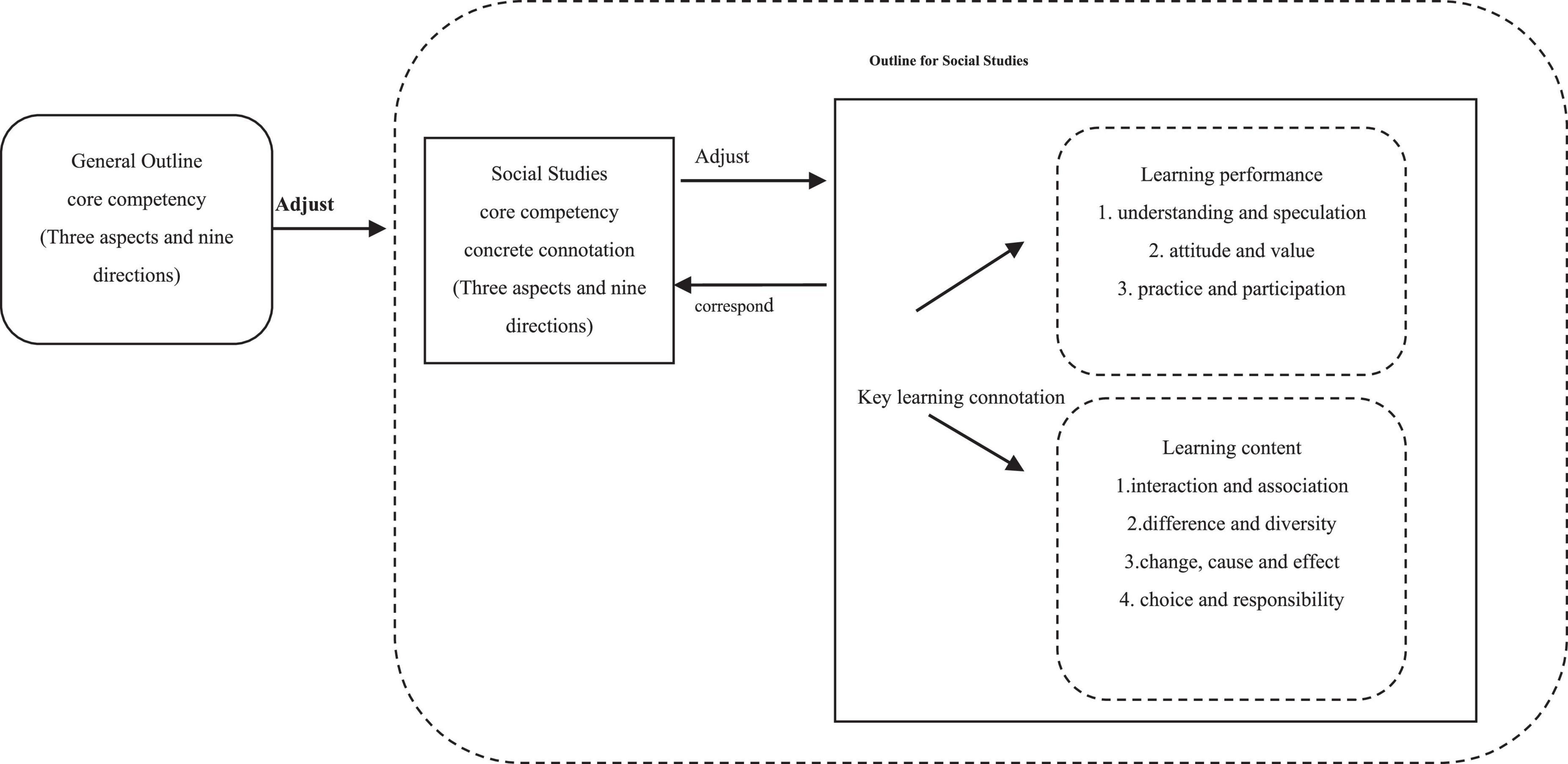
Figure 2. The relationship between the general outline and social studies outline (source: Ministry of Education, 2014, 2018; Chan, 2020).
The general outline shares three aspects with the social studies outline. First, key learning connotations include both learning performance and learning content. Second, learning performance is based on understanding and speculation, attitudes and values, and practice and participation. Finally, the learning content is aimed at teaching students about interaction and association; difference and diversity; change, cause, and effect; and choice and responsibility (Ministry of Education, 2018).
2.6 Concrete connotations of core competencies in elementary social studies
The concept of core competencies in 12-Year Basic Education emphasizes lifelong learning. These competences are divided into three broad dimensions, namely, autonomous action, communication and interaction, and social participation. Each dimension involves three items. Specifically, spontaneity entails physical and mental wellness and self-advancement; logical thinking and problem solving; and planning, execution, innovation and adaptation. Communication and interaction entails semiotics and expression; information and technology literacy and media literacy; and artistic appreciation and aesthetic literacy. Finally, social participation entails moral praxis and citizenship; interpersonal relationships and teamwork; and cultural and global understanding (Ministry of Education, 2014).
The concrete connotations of the core competencies in social studies listed in Table 1.
2.7 Considering this local study is of global importance–Sustainable Development Goals and teaching design for children’s cultural learning for sustainability
Sustainability is a much debated concept. Environmental sustainability refers to the responsible and balanced management of natural resources and ecosystems to ensure their long-term health and resilience while meeting the needs of current and future generations (James, 2024; Malin et al., 2024).
In 1962, the American biologist Rachel Carson published the book Silent Spring, which revealed the dangers of DDT pesticides in times of rapid industrial development. In 1970, the United States became the first country to establish laws regarding environmental education. Over the following 10 years, United Nations (UN) conferences focused on the environment and sustainability. The purpose of environmental education is not only to solve environmental problems but also to emphasize intergenerational justice as the core of sustainable development (Yeh, 2017; Chen, 2023; Feng, 2023).
In 1987, the UN World Commission on Environment and Development published the Brundtland Report, also known as Our Common Future, which defined sustainable development as “development that meets the needs of the present generation without jeopardizing the ability of the next generation to meet their needs.” The Brundtland Report highlighted the necessity of sustainable development to balance the economy, society, and the environment and sparked many initiatives promoting education on sustainable development. For example, the UN’s decade of education for sustainable development (2005–2014) plan proposed taking action through education to instill skills of critical thinking, communication, coordination, and conflict resolution in students. Moreover, the plan emphasized the goal of educating global citizens who can respect the lives and cultures of others (Yeh, 2017; Chen, 2023; Feng, 2023).
The term “sustainability” is known to be a solution to environmental and social problems. Sustainability is defined as “meeting the needs of the present without compromising the ability of future generations to meet their own needs.” It emphasizes “social, economic and environmental sustainability and the interaction of these three elements” (Huang and Cheng, 2022). In education, education for sustainable development is a term used by the United Nations and is defined as education that encourages changes in knowledge, skills, values, and attitudes to enable a more sustainable and just society for all (Zhang et al., 2023).
Education for sustainable development (ESD) is UNESCO’s education sector response to the urgent and dramatic challenges the planet faces. In 2015, the “2030 Agenda for Sustainable Development” and Sustainable Development Goals (SDGs) were passed by the UN Assembly, 195 nations agreed with the UN that they can change the world for the better. This will be accomplished by bringing together their respective governments, businesses, media, institutions of higher education, and local NGOs to improve the lives of the people in their country by the year 2030. The Global Challenge for Government Transparency: The Sustainable Development Goals (SDGs) 2030 Agenda. Here’s the 2030 Agenda: (1) eliminate poverty; (2) erase hunger; (3) establish good health and wellbeing; (4) provide quality education; (5) enforce gender equality; (6) improve clean water and sanitation; (7) grow affordable and clean energy; (8) create decent work and economic growth; (9) increase industry, innovation, and infrastructure; (10) reduce inequality; (11) mobilize sustainable cities and communities; (12) influence responsible consumption and production; (13) organize climate action; (14) develop life below water; (15) advance life on land; (16) guarantee peace, justice, and strong institutions; (17) build partnerships for the goal (Yeh, 2017; New Jersey Minority Educational Development, 2023; UNESCO, 2023).
The Sustainable Development Goals (SDGs) are a widely accepted framework for promoting sustainable development. SDG4 goal 4.7 pursues the “sustainability” of education to promote sustainable development for country (Sánchez-Carracedo et al., 2021). SDG11 pursues “sustainable cities and communities” in efforts to make them inclusive, safe, and resilient. SDG 11.4 protects countries’ cultural and natural heritage and the cultural landscape that embodies the collective memory and history of the people on the land.
This study designed teaching activities aimed at helping children to understand, visit, see, and care for Beigang; actively protect Taiwan’s culture and heritage; and respect the people’s collective memory and history. It is hoped that such teaching practice can inspire children to care about their living environment and promote the sustainable development of their living environment. This local study is of global importance. The discussion draws meaningful connections with other research studies (Farhana et al., 2017; Huang and Cheng, 2022).
3 Proposed teaching design for children’s cultural learning for sustainability at elementary school in Taiwan
Beigang’s Township, formerly known as “Ponkan (笨港),” is in the southwest of Yunlin County, Taiwan. Beigang is a small town with a rich history; it is a center of Mazu belief, one of the three major towns in Yunlin, and the gateway to the Yunlin coast. Beigang is also the political and economic center of Yunlin and is a key town for transportation, sightseeing, culture, medical care, and education. The old street features several historic sites that have a long and prosperous history.
3.1 The proposed course design has the following goals
Strengthen children’s understanding and connection with Beigang’s history and culture.
Teach children about Beigang’s cultural characteristics.
Enable children to identify with their hometown-Beigang.
Assist children with applying knowledge in practical situations.
Children will be taught Beigang’s local characteristics through the proposed course design, which can promote the public welfare. The proposed course design also applies the concepts of “taking initiative,” “engaging in interaction,” and “seeking the common good” from the Curriculum Guidelines of 12-year Basic Education and develops courses that cultivate students’ educational competencies.
This course considered the regional, ethnic, and school characteristics for curriculum development, and prioritize real-world experience. This course improved the quality of independent thinking, value judgments, rational decision-making, innovation, and social participation (Ministry of Education, 2018). Enhance the exploration and knowledge of history, and geography. Cultivate children’s awareness of ethnic groups, societies, localities, countries, and the world and instill a sense of responsibility that includes the recognition of diversity, value of human rights, and concern for global sustainability (Ministry of Education, 2018; Shih, 2020).
3.2 Tips for designing teaching activities
Lesson plan structure: understand Beigang, visit Beigang, see Beigang, care Beigang.
Analysis on teacher preparation and materials: hold a meeting to discuss incorporating the key points into each subject.
Student preparation: help students develop the ability to discuss, think critically, and brainstorm ideas during the course.
3.3 Teaching process
Phase 1: Getting to understand Beigang.
Phase 2: Visiting Beigang. Combine off-campus teaching and tours of historical sites.
Phase 3: Seeing Beigang. Introduce the geography and natural scenery of Beigang.
Phase 4: Caring for Beigang. Introduce the beauty and future of Beigang.
3.4 Core competency questions, major domain, and subdomains
The researcher first considered questions on core competencies and then considered questions regarding the major domain and subdomains. The major domain was social studies, and the subdomains were integrative activities, language arts, and arts. The core competency questions were as follows:
(1) How much do you know Beigang?
(2) How has Beigang affected your life?
(3) What are the elements of an explanatory text?
(4) How can an attractive postcard from Beigang be designed?
(5) How can students contribute to Beigang’s public welfare?
The core competency questions, major domain, and subdomains are presented in Figure 3.
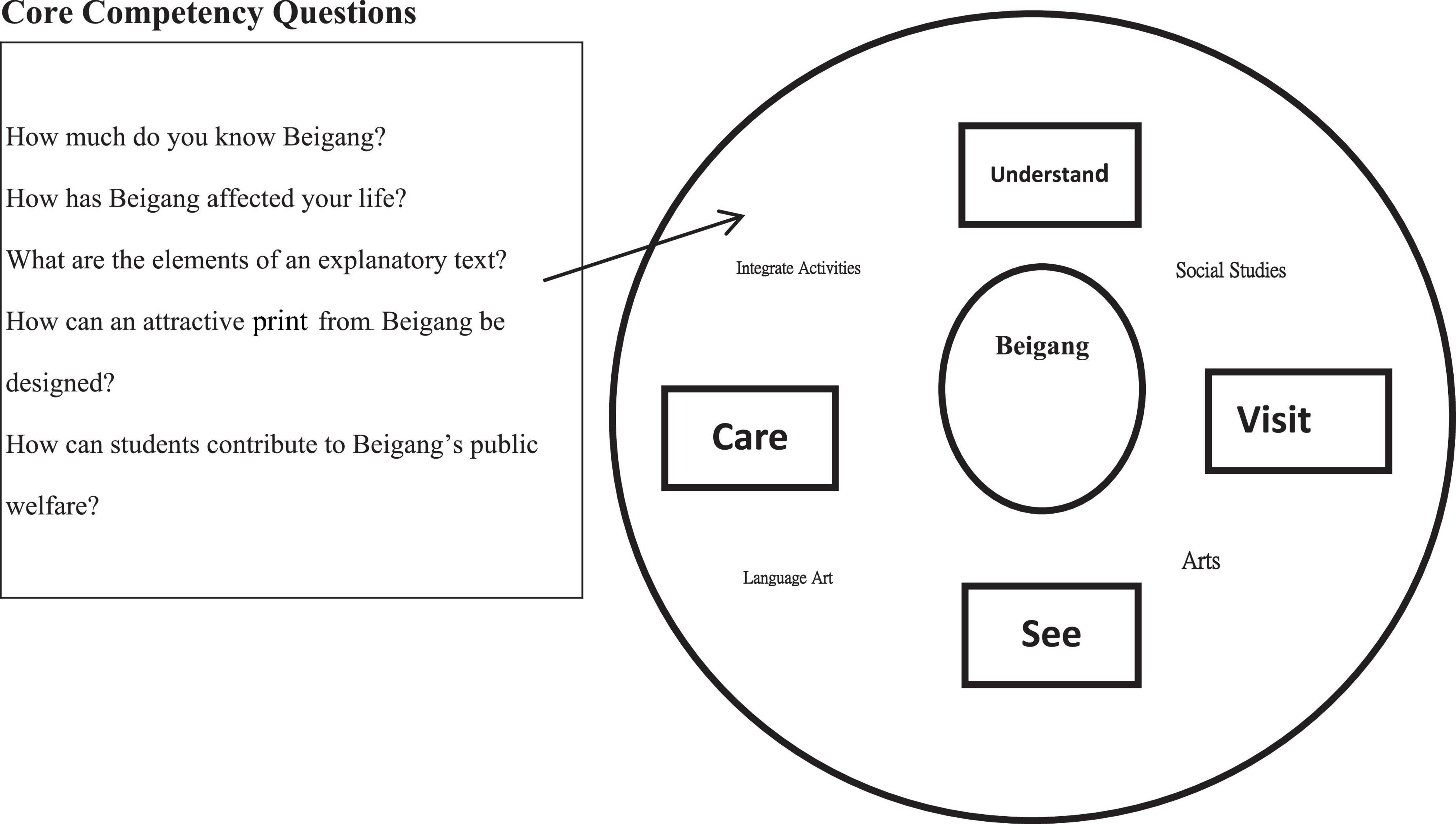
Figure 3. The core competency questions, major domain, and subdomains (source: developed in this study).
4 Research method
4.1 Documentary analysis method
This study employed the documentary analysis method, which involves the use of documents as the primary data source. Documentary analysis is a qualitative research approach in which the researcher interprets documents to derive meaningful insights on a particular topic (Wang and Shih, 2022, 2023). In this study, the researcher applied the documentary analysis method to analyze issues related to social studies education in Taiwan’s elementary schools. Additionally, the principle of the curriculum outline for social studies was analyzed. Finally, the researcher used analytical and interpretive skills to establish connections with the objectives of the United Nations’ SDGs.
4.2 Case study
Qualitative case studies enable researchers to investigate complex phenomena by identifying relevant factors and observing their interaction. Case studies involve diverse methods of data collection—such as observation, interviews, surveys, and document analysis—along with comprehensive descriptions provided by the study participants (Shih, 2022). In the present study, data were collected through semistructured interviews that followed a predefined outline. The interviewees were both teachers and students, and they shared their perspectives and insights regarding the social studies curriculum.
4.3 Elementary school selected for the case study
The elementary school featured in this case study is located in Yunlin County, Taiwan, and was established in 1927. The school is guided by a set of educational principles that revolve around a humanistic spirit, diverse and dynamic teaching management, the fostering of warm teacher–student friendships, and the promotion of a vibrant and wholesome childhood experience for its students.
4.4 Data collection
The primary data source in this study was interview transcripts, and the collected data were systematically coded using self-developed categories. The researcher visited the elementary school to conduct semistructured interviews with the teacher and students on 16 June 2023. All the interviewees had been actively involved in the planning and design of the social studies course. During the interviews, the interviewees freely expressed their opinions regarding the course. Prior to their participation, the interviewees were informed about the study’s objectives, and they provided their informed consent. Consent letters and interview outlines were shared with the interviewees, including the teachers and the students’ parents (Shih, 2022). Each interview session lasted approximately 1 h. The demographic details of the interviewees are presented in Tables 2–4 outlines the interview coding method.
The codes correspond to the interviewees and dates. For example, “Coordinator interview, A20190612” corresponds to the interview with the elementary school teacher who serves as the coordinator of the social studies program; this interview was conducted on 16 June 2023. “Student interview 1, A20230616” corresponds to the interview with student 1, a participant, conducted on 16 June 2023.
4.5 Course design: Beigang
4.5.1 Tiâu-thian Kiong (朝天宮)
Tiângthian esign, which locals call má tsóo king (媽祖宮), is the most famous landmark in Beigang Township (Figure 4). Established in 1694 AD during the Kangxi period of the Qing dynasty. Tiownship. Estab serves as the main temple for more than 300 Mazu temples across the country. The Tiemples across is dedicated to many gods, such as Mazu and Guanyin. The beam frames and wood carvings in the temple were all created by famous craftsmen. The stone statues of the Dragon Kings of the Four Seas perched along the stone railings outside the temple exemplify the religious and artistic masterpieces of the temple. The Tie frames and welcomes worshippers throughout the year. The liveliest times to visit are during the Lantern Festival on the 15th day of the first month of the lunar calendar and Mazu’s birthday on March 23. Mazu’s birthday, visitors come to Beigang from across the world, and the entire city is shrouded in a festive atmosphere.
4.5.2 Beigang Daughter Bridge (北港女兒橋)
The Beigang Daughter Bridge was constructed from Taiwan’s oldest iron bridge, the Beigang–Fuxing Iron Bridge (Figure 5). The small train that once operated over the bridge is no longer in service; however, the dragon-shaped bridge has become a hotspot for photos and social media check-ins. In the evenings, people can enjoy the sunset while walking over the Beigang River Head.
4.5.3 Beigang Cultural Center (北港文化中心)
To learn more about Mazu rituals, a visit to the Beigang Cultural Center is a must. The center describes the process of circumambulation and the roles of participants in the ritual, such as the leader of the procession (bao ma zai) (報馬仔), costume makers (zhuang yi tuan) (莊儀團) and ritual band (kai lu gu) (開路鼓). The cultural center hosts many other temporary exhibitions.
4.5.4 Beigang Starbucks (北港星巴克)
The first Starbucks store in Beigang is on Huanan Road (Provincial Highway 19), the main road entering and leaving Beigang (Figure 6). The architecture of the store reflects the religious characteristics of the town; religious imagery is present from the exterior and interior walls to the grille ceiling. Through the simple reddish-brown tones that resemble temple interiors, the pious, solemn architectural style exudes history and local sentiment.
4.5.5 Beigang Old Street (北港老街)
Beigang Old Street, located south of Tiâu-thian Kiong, has local flair (Figure 7). Baroque buildings line both sides of the street, and the shops sell local treats and produce that are popular among tourists. Pilgrimage groups from across Taiwan are a common sight. The street is lively, and the atmosphere is truly unique and worth experiencing.
4.6 Limitation
This research is a case study, and this curriculum is only implemented in one school in Taiwan, so the validity of extrapolation to other case schools will be limited.
5 Findings
5.1 Curriculum development connected to the pulse of life, a sense of care for local communities, and cultivation of local thinking
The social studies curriculum is intricately connected to the pulse of life, a sense of care for local communities, and cultivation of local thinking. The approach employed in the curriculum aims to enable children to not only connect with their own country and culture but also embrace the role of being a global citizen (Ministry of Education, 2018). Student 2 stated the following:
Beigang Old Street (北港老街) is so vibrant and filled with people. I like Beigang Old Street. I see many ancient buildings on the street, and I feel a need to protect them (Student interview 2, C20230616).
Student 4 expressed the following:
I like Tiâu-thian Kiong (朝天宮). My grandma used to take me to worship there. She has passed away. Whenever I visit Tiâu-thian Kiong, I miss my grandma. For me, Tiâu-thian Kiong symbolizes my grandma (Student interview 4, D20230616).
5.2 Child-centered and problem-oriented curriculum that integrates students’ interests and the local environment into the learning process
This social studies curriculum is designed to be child-centered and problem-oriented and to integrate students’ interests and the local environment into the learning process. This approach equips students with the skills to observe, investigate, collect data, create diagrams and thematic maps, write reports, inquire, and acquire other practical competencies (Ministry of Education, 2018). Therefore, teachers must adopt a competency-oriented curriculum design and teaching approach. To illustrate competency-oriented curriculum design and teaching, Fan (2016) introduced a concept map containing four interconnected circles (Figure 3). Competency-oriented curricula and teaching seamlessly integrate knowledge, skills, and attitudes, emphasizing that learning should not be solely centered on knowledge acquisition. Additionally, learning should be situational and contextualized, and the learning content should include appropriate real-life experiences, events, situations, and contexts. Furthermore, curriculum planning and teaching must combine learning content with scientific inquiry, placing substantial emphasis on learning processes, strategies, and methods. This approach can help cultivate self-learning and life-long learning. Finally, classroom activities should give students opportunities to apply their knowledge and develop transferrable skills that can be effectively employed in real-world scenarios (Fan, 2016). The concept map of competency-oriented curricula and teaching in social studies is displayed in Figure 8.

Figure 8. The concept map of competency-oriented curricula and teaching in social studies (source: Fan, 2016).
The aim of the design of the course investigated in this study was to synthesize children’s knowledge, skills, and attitudes and to emphasize the importance of situational teaching, contextualized learning, and the practical application of knowledge. The cultural course enables students visiting Beigang to learn about the town’s cultural landscape, interact and communicate with people, and participate in sustainable development in their hometown. Through this educational experience, children can learn how to be sensitive, caring, introspective, and respectful toward their hometown and contribute to the creation of a better living environment. The course fosters children’s cultural learning to the benefit of the sustainability of their hometown.
The teacher asked the following questions:
Let’s review Beigang again.
Where are you from?
Do you love your hometown?
How can you contribute to the sustainable development of your hometown?
Student 5 stated the following:
I love my hometown, Beigang. I want to keep Beigang beautiful forever (Student interview 5, E20230616).
Student 6 expressed the following:
I love Beigang, my hometown. I’m going to the Beigang Sports Park to help plant trees so that there will be more and more trees. Then, the air in Beigang will get better and better, and the people living in Beigang will become healthier (Student interview 6, F20230616).
Student 7 stated the following:
I love my hometown, Beigang. I’m going to the Beigang Fruit and Vegetable Market to help remove trash. I want Beigang to become cleaner (Student interview 7, G20230616).
5.3 Improving students’ competencies and skills in the context of sustainability
The pursuit of sustainable development, in alignment with the United Nations’ SDGs, is a top priority in both the internal and external policies of the Union. As acknowledged by the UN 2030 Agenda, a commitment to sustainable development is reflected through the endorsement of 17 universal SDGs and related targets. These goals aim to strike a balance across all dimensions of sustainable growth, such as economic, environmental, and social considerations (Fleaca et al., 2023).
Education on sustainability should be capable of cultivating the mindset and skills to meet the complex sustainability challenges faced in the 21st century. The critical roles of teachers in this context were thoroughly analyzed in this study, and the findings underscore the importance of teachers in cultivating students’ sustainability competencies and skills (Chatpinyakoop et al., 2022; Fleaca et al., 2023). Therefore, the design of the social studies course aims to foster the development of students’ sustainability competencies and skills in the context of sustainability.
The teacher gave the following description:
“Course design: Beigang” increases the awareness of the changes in students’ social, natural, and human environments. Moreover, it equips students to be able to pay attention to everyday problems and the effects of these problems on their lives as well as to consider possible solutions. For example, the Beigang Daughter Bridge (北港女兒橋) was constructed from Taiwan’s oldest iron bridge, the Beigang–Fuxing Iron Bridge. The small train that once operated over the bridge is no longer in service; however, the dragon-shaped bridge has become a hotspot for photos and social media check-ins. The original old railway has been redesigned and become a new tourist attraction. The teacher described the transformation of the bridge, and the students experienced the renewal of the bridge and pledged to take good care of it (Coordinator interview, A20230616).
Student 1 stated the following:
I like Matsu. Matsu blesses those who live in Beigang. I want to protect Tiâu-thian Kiong (朝天宮). Mazu lives in Tiâu-thian Kiong, and if Tiâu-thian Kiong were to be destroyed, Matsu would have nowhere to live (Student interview 1, A20230616).
Student 3 expressed the following:
Beigang Old Street (北港老街) is so vibrant and filled with people. I like Beigang Old Street. I see many ancient buildings on the street, and I feel a need to protect them (Student interview 3, C20230616).
6 Discussion
6.1 A social studies curriculum should adapt to social problems and focus on students’ life experiences, and cultivate caring in students in curriculum
Children are surrounded by many influential role models in society—for example, parents, siblings, teachers, friends, and TV characters—and their learning occurs through being explicitly taught by others, through direct observation, and through participation in activities. These are students’ life experiences (Farhana et al., 2017; Ye and Shih, 2021). A social studies curriculum should adapt to social problems and focus on students’ life experiences, and cultivate caring in students in curriculum. After all, children learn to care for those around them through life experiences (Hung et al., 2021; Shih et al., 2022; Shih, 2024).
6.2 This curriculum overcomes the shortcomings of knowledge-based learning
Teachers and students often spend excessive time mastering and memorizing content. Moreover, previous curricula were bloated and failed to instill in students the key skills and core literacies required to face a changing world. Therefore, the 12-Year Basic Education Curriculum focuses on literacy, is based on both learning content and learning performance, emphasizes active inquiry and practice, and hopes to prevent excessive memorization. Therefore, this curriculum overcomes the shortcomings of knowledge-based learning by providing a high-quality educational experience, and campus sustainability (Ministry of Education, 2014, 2018, 2019; Hung et al., 2020; Washington-Ottombre, 2024).
6.3 Select appropriate themes, and at least one inquiry activity should be designed for each unit
In order to implement and link up the exploration and practice courses that are valued at the junior and senior high school stages, the key points of implementation in the new curriculum in the social studies are to standardize the “compilation and selection of textbooks for elementary schools or the compilation of textbooks for textbooks and the design of integrated curriculum in fields.” In addition to selecting appropriate themes to develop comprehensive teaching materials, at least “one inquiry activity should be designed for each unit, and each semester should integrate the content learned in the semester, and at least one theme inquiry and practice unit should be planned.” Therefore, at the elementary school site, different from traditional teaching methods and habits, guide students to explore and practice in the social field, and then cultivate children’s core literacy (Ministry of Education, 2014; Yu, 2023).
7 Conclusion and implication
7.1 Conclusion
The findings of this study were as follows: (1) The social studies curriculum development in Taiwan is connected to the pulse of life, a sense of care for local communities, and cultivation of local thinking. (2) This social studies curriculum adopts a child-centered and problem-oriented approach and integrates students’ interests and the local environment into the learning process. (3) It effectively enhances students’ sustainability-related competencies and skills.
These findings offer valuable insights for teachers and can enable them to shape the direction of their social studies courses and cultivate children’s concept of sustainable development. In addition, the sustainability competences are systems thinking competence, futures thinking competence, values thinking competence, collaboration competence and action-oriented competence (Marjo and Ratinen, 2024). In values thinking competence, this study effectively enhances students’ sustainability-related competencies and skills. The existing sustainability competencies’ frameworks are linked to social studies curriculum and the learning outcomes that were sought in this case study.
In the end, ensuring a fair and decent livelihood for all people, regenerating nature and enabling biodiversity to thrive, have never been more important for sustainable development (Bianchi et al., 2022). In addition, hundreds of sustainability programs have emerged at schools around the world over the past 2 decades. A prime question for employers, students, educators, and program administrators is what competencies these programs develop in students (Brundiers et al., 2021). In this study, Taiwanese children can protect cultural and natural heritage and the cultural landscape that embodies the collective memory and history of the people on the land in the sustainable future.
7.2 Implication
In the 21st century, the world has become more globalized. Globalization has decreased distinctions between countries and has increased interdependency among countries (Wang and Shih, 2023). However, one of the biggest challenges that globalization poses to blurr the unique local cultural characteristics. in recent years, awareness of local culture, which is based on cultural transmission with respect to language, history, geography, knowledge, customs, art, and an appreciation of the value of local identity and traditional culture, has become a priority. Local culture has become a crucial part of education in Taiwan, and they help children better appreciate the culture styles behind their everyday lives (Shih, 2022). This local study is of global importance.
Finally, the growing international significance of education for sustainable development (ESD), and is a matter of global importance, the requirements and needs of people differ according to their regional circumstances (de Haan, 2006, 2010). To create a more sustainable world and to engage with issues related to sustainability as described in the Sustainable Development Goals (SDGs), individuals must become sustainability change-makers. They require the knowledge, skills, values and attitudes that empower them to contribute to sustainable development (UNESCO, 2017).
The trend toward the standardization of education raises the question of why teachers should focus on local contexts (Smith and Sobel, 2010). Historically, before the advent of common schools, education grounded in local concerns and experiences was the norm, playing a crucial role in transitioning from childhood to adulthood. However, in modern schooling, children often experience a growing disconnect between their community lives and classroom experiences (Smith and Sobel, 2010). Hence, elementary teachers in Taiwan are recommended to focus on actively incorporating local cultural elements into the classroom. This approach aims to bridge the gap between children’s community experiences and their educational environment. This study is of local importance in Taiwan.
Data availability statement
The original contributions presented in this study are included in this article/supplementary material, further inquiries can be directed to the corresponding author.
Ethics statement
Ethical approval was not required for this study involving human participants in accordance with the local legislation and institutional requirements. Written informed consent was obtained from the individual(s), and minor(s)’ legal guardians/next of kin, for participation in this study and for the publication of any potentially identifiable images or data included in this article.
Author contributions
Y-HS: Writing – original draft, Writing – review & editing.
Funding
The author declares that no financial support was received for the research, authorship, and/or publication of this article.
Conflict of interest
The author declares that the research was conducted in the absence of any commercial or financial relationships that could be construed as a potential conflict of interest.
Publisher’s note
All claims expressed in this article are solely those of the authors and do not necessarily represent those of their affiliated organizations, or those of the publisher, the editors and the reviewers. Any product that may be evaluated in this article, or claim that may be made by its manufacturer, is not guaranteed or endorsed by the publisher.
References
Bianchi, G., Pisiotis, U., and Cabrera Giraldez, M. (2022). GreenComp The European Sustainability Competence Framework, eds Y. Punie and M. Bacigalupo (Luxembourg: European Union).
Brundiers, K., Barth, M., Cebrián, G., Cohen, M., Diaz, L., and Doucette-Remington, S. (2021). Key competencies in sustainability in higher education—toward an agreed-upon reference framework. Sustainability Sci. 16, 13–29. doi: 10.1007/s11625-020-00838-2
Chan, P. J. (2020). “Literacy-oriented curriculum and teaching in social studies,” in Teaching materials and methods in social studies in elementary school, ed. Chen and Chan (Taipei City: Wunan), 31–46.
Chatpinyakoop, C., Hallinger, P., and Showanasai, P. (2022). Developing capacities to lead change for sustainability: a quasi-experimental study of simulation-based learning. Sustainability 14:10563.
Chen, W. Z. (2023). After 50 Years, Scholars Published a Book Review “Rachel Carson – The Pioneer Who Created a New World of Environmental Protection with His Pen”. Available Online at: https://www.bbc.com/zhongwen/trad/57638398
de Haan, G. (2006). The BLK ‘21’ programme in Germany: a ‘Gestaltungskompetenz’-based model for education for sustainable development. Environ. Educ. Res. 12, 19–32. doi: 10.1080/13504620500526362
de Haan, G. (2010). The development of ESD-related competencies in supportive institutional frameworks. Int. Rev. Educ. 56, 315–328. doi: 10.1007/s11159-010-9157-9
Fan, H. H. (2016). Core competencies and the twelve-year national basic education curriculum outline: a guide to “national core competencies: the DNA of the twelve-year national education curriculum reform. Educational Pulse 5.
Farhana, B., Winberg, M., and Vinterek, M. (2017). Children’s learning for a sustainable society: influences from home and Preschool. Educ. Inq. 8, 151–172. doi: 10.1080/20004508.2017.1290915
Feng, D. Y. (2023). Understanding SDGs, Pulsating with the World. Available Online at: www.sdec.ntpc.edu.tw/p/405-1000-1672,c228.php?Lang=zh-tw (accessed December 2, 2023).
Fleaca, B., Fleaca, E., and Maiduc, S. (2023). Framing teaching for sustainability in the case of business engineering education: process-centric models and good practices. Sustainability 15:2035. doi: 10.3390/su15032035
Huang, H., and Cheng, E. W. L. (2022). Sustainability education in china: lessons learnt from the teaching of geography. Sustainability 14:513.
Hung, L. C., Liu, M. H., and Chen, L. H. (2020). Analysis of cross-curricular activities in social studies textbooks for junior high schools: a competence-oriented design perspective. J. Textbook Res. 13, 1–32. doi: 10.6481/JTR.202012_13(3).01
Hung, L. C., Liu, M. H., and Chen, L. H. (2021). Content analysis on inquiry tasks in Taiwan’s elementary social studies textbooks from the perspective of inquiry-based design. J. Textb. Res. 14, 43–77. doi: 10.6481/JTR.202112_14(3).02
James, N. (2024). Urbanization and its impact on environmental sustainability. J. Appl. Geogr. Stud. 3, 54–66. doi: 10.47941/jags.1624
Malin, B., Pettersson, K., and Westberg, L. (2024). Tracing sustainability meanings in rosendal: interrogating an unjust urban sustainability discourse and introducing alternative perspectives. Local Environ. doi: 10.1080/13549839.2023.2300956
Marjo, V., and Ratinen, I. (2024). Sustainability competences in primary school education – a systematic literature review. Environ. Educ. Res. 30, 56–67. doi: 10.1080/13504622.2023.2170984
Ministry of Education (2014). Curriculum Guidelines 12-year Basic Education: General Guidelines. Taipei: Ministry of Education.
Ministry of Education (2018). 12-year Basic Education Curriculum Outline–National Primary and Secondary Schools and Senior High Schools-Social Studies. Taipei: Ministry of Education.
Ministry of Education (2019). 12-year Basic Education Curriculum Outline–National Primary and Secondary Schools and Senior High Schools-Social Studies (Course Manual). Taipei: Ministry of Education.
New Jersey Minority Educational Development (2023). The Global Challenge for Government Transparency: The Sustainable Development Goals (SDG) 2030 Agenda. Available Online at: https://worldtop20.org/global-movement/ (accessed December 2, 2023).
Sánchez-Carracedo, F., Moreno-Pino, F., Romero-Portillo, D., and Sureda, B. (2021). Education for sustainable development in Spanish university education degrees. Sustainability 13:1467. doi: 10.3390/su13031467
Shih, Y. H. (2020). Learning content of ‘multiculturalism’ for children in Taiwan’s elementary schools. Policy Futures Educ. 18, 1044–1057. doi: 10.1177/1478210320911251
Shih, Y. H. (2022). Designing culturally responsive education strategies to cultivate young children’s cultural identities: a case study of the development of a preschool local culture curriculum. Children 9:1789. doi: 10.3390/children9121789
Shih, Y. H. (2024). Case study of intergenerational learning courses implemented in a preschool: perceptions of young children and senior citizens. Educ. Gerontol. 50, 11–26. doi: 10.1080/03601277.2023.2216089
Shih, Y. H., Chen, S. F., and Ye, Y. H. (2020). Taiwan’s “white paper on teacher education”: vision and strategies. Universal J. Educ. Res. 8, 5257–5264.
Shih, Y. H., Wu, C. C., and Chung, C. F. (2022). Implementing intergenerational learning in a preschool: a case study from Taiwan. Educ. Gerontol. 48, 565–585. doi: 10.1080/03601277.2022.2053035
Smith, G. A., and Sobel, D. (2010). Place- and Community-Based Education in Schools. New York: Routledge.
Wang, R. J., and Shih, Y. H. (2022). Improving the quality of teacher education for sustainable development of Taiwan’s education system: a systematic review on the research issues of teacher education after the implementation of 12-year national basic education. Front. Psychol. 13:921839. doi: 10.3389/fpsyg.2022.921839
Wang, R. J., and Shih, Y. H. (2023). What are universities pursuing? a review of the quacquarelli symonds world university rankings of Taiwanese universities (2021–2023). Front. Educ. 8:1185817. doi: 10.3389/feduc.2023.1185817
Washington-Ottombre, C. (2024). Campus sustainability, organizational learning and sustainability reporting: an empirical analysis. Int. J. Sustainab. High. Educ. doi: 10.1108/IJSHE-12-2022-0396 Online ahead of Print.
Ye, Y. H., and Shih, Y. H. (2021). Development of John Dewey’s educational philosophy and its implications for children’s education. Policy Futures Educ. 19, 877–890. doi: 10.1177/1478210320987678
Yeh, S. C. (2017). Exploring the developmental discourse of environmental education and education for sustainable development. J. Environ. Educ. Res. 13, 67–109.
Yu (2023). [Society] When Exploration and Practice Meet the New Curriculum of Elementary School Social Studies.
Keywords: children, social studies, sustainability, the curriculum outline for social studies, the Curriculum Guidelines of the 12-Year Basic Education
Citation: Shih Y-H (2024) Children’s learning for sustainability in social studies education: a case study from Taiwanese elementary school. Front. Educ. 9:1353420. doi: 10.3389/feduc.2024.1353420
Received: 10 December 2023; Accepted: 29 February 2024;
Published: 16 April 2024.
Edited by:
Diana Hernández Montoya, Universidad Estatal a Distancia, Costa RicaReviewed by:
Niroj Dahal, Kathmandu University, NepalGisela Cebrián, University of Rovira i Virgili, Spain
Copyright © 2024 Shih. This is an open-access article distributed under the terms of the Creative Commons Attribution License (CC BY). The use, distribution or reproduction in other forums is permitted, provided the original author(s) and the copyright owner(s) are credited and that the original publication in this journal is cited, in accordance with accepted academic practice. No use, distribution or reproduction is permitted which does not comply with these terms.
*Correspondence: Yi-Huang Shih, c2hpaDI2MkBnbWFpbC5jb20=
 Yi-Huang Shih
Yi-Huang Shih